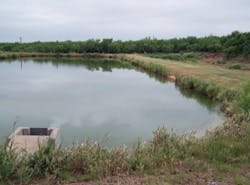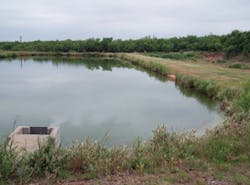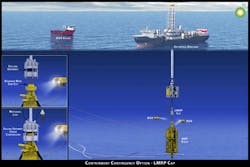Introduction to Wastewater Treatment Ponds
By Mark E. Goad
The most often used ponds in domestic wastewater treatment are the stabilization pond and facultative lagoon. The stabilization pond is designed to be aerobic throughout its depth and the facultative lagoon will be anaerobic at the bottom and aerobic at the top. This article will examine the normal uses of each of these treatment ponds.
Stabilization ponds provide secondary biological treatment and are the most commonly used wastewater pond. Stabilization ponds must be preceded by some form of primary treatment such as an Imhoff tank or a primary clarifier to reduce the solids entering the pond. When secondary permitting came into being, many small and/or rural utilities that just had primary treatment added stabilization ponds to comply with the secondary treatment rules.
Most states require multiple ponds in series with detention times of 30 days plus. Average depths are three to five feet deep. All ponds must be constructed with impervious material such as clay or an artificial liner to prevent contamination of groundwater and surface water sources in the area.
Typical design parameters are:
- Multiple submerged inlets and outlets to minimize short circuiting.
- Two to three feet of freeboard as protection against overflow during periods of heavy rainfall.
- The slope of the embankment should be one to three feet vertical to horizontal.
- Length to width ratio of three to one
- Embankments and slopes must be protected against erosion by a type of grass (preferred) or rip-rapping.
- Detention times of 30 days plus.
Typical pond loadings of 35 to 50 pounds of BOD per surface acre per day are normal. One surface acre will provide treatment for 300 to 400 people, depending on state regulations. Therefore stabilization ponds are more suited to small and rural utilities that have large land areas available at reasonable cost.
Facultative lagoons are similar in design to stabilization ponds except design depth is five to eight feet. These ponds do not require primary treatment and the added depth is needed to handle the substantial increase in solids loadings. It is common for the depth near the inlets to be 10 to 12 feet.
The bottom of a facultative pond provides a storage area where anaerobic and facultative bacteria slowly stabilize the organic material. The surface area will maintain aerobic conditions.
Facultative lagoons are most often used in conjunction with stabilization ponds. Many rural utilities use ponds as their sole form of wastewater treatment. The first pond or the first half of the first pond will be a facultative lagoon with depths of approximately 10 feet. The rest of the pond system will be stabilization ponds with depths of three to five feet. Detention time will usually be 30 days plus and will do an excellent job of stabilizing the organic material in the sewage. However, ponds are not designed to discharge an extremely clean effluent where low BOD/TSS is needed or desired.
A typical pond permit will be 30 BOD, 90 TSS. The treatment system will generate its own natural BOD and TSS. With the processes involved, dissolved oxygen will usually be good and pH close to 7. A typical pond permit will require monitoring of BOD, TSS, flow, DO and pH. In some rare situations fecal coliform or chlorine residual could be required. Regulations differ from state to state.
Pond systems stabilize organic material through natural processes involving sunlight, water, nutrients, algae, atmospheric oxygen and bacterial action. Organic matter in the wastewater is broken down by aerobic bacteria and oxygen found in the pond. This process releases carbon dioxide which is used by the algae to produce simple sugars through a process known as photosynthesis. Oxygen is the by-product of this reaction which is used by other aerobic bacteria to stabilize more organic matter. This becomes a continuous cycle.
The process is aerobic and therefore is based on oxygen. Oxygen is used by the microorganisms to stabilize organic matter. More organic matter requires more oxygen. During daylight hours photosynthesis operates and oxygen is produced. This process puts DO in the pond water. At night photosynthesis stops and all the organisms become oxygen consumers which can greatly reduce the DO levels in the pond. DO levels are also dependent upon depth. Surface levels will have higher DO levels and as the depth increases it becomes more difficult for sunlight to penetrate therefore DO levels decline.
Ponds use a multitude of organisms in the treatment process. Bacteria, algae, protozoa, and insects all have a part of the treatment in a pond system. These organisms coupled with sunlight, oxygen, and long detention times do an effective job of reducing fecal coliform and lowering ammonia levels. In the summer blue-green algae tend to dominate with high organic loadings. The nitrogen associated with ammonia in wastewater stimulates the growth cycle of blue-green algae. A large bloom will be evident by an obnoxious, pig-pen odor. While it is disagreeable to smell, it is effective in reducing ammonia concentrations.
Most ponds are somewhat maintenance free. Many are designed with no pumps and motors. All flows are by gravity. This minimizes maintenance and does not require a lot of operating attention. What maintenance is required is mowing of the property and preventing the growth of cattails and other shallow water plants at the water’s edge. Care must be taken to insure nuisance animals such as beavers, nutria rats, and alligators do not destroy the levees.
The pond system can eliminate 80% to 90% of the BOD and reduce bacteria to levels comparable to other accepted oxidation types of treatment. This type of treatment system meets the needs of many small or rural communities due to low construction costs as well minimal operation and maintenance requirements. The down side is the amount of property required for a system of this type.
WW
About the Author: Mark E. Goad is a Training Specialist with the Texas Engineering Extension Service (TEEX®) of the Texas A&M University System. A course entitled Lagoon and Pond Wastewater Treatment is among several authored by TEEX trainers that are available on the WaterWorldCE.com continuing education website.
More WaterWorld Current Issue Articles
More WaterWorld Archives Issue Articles


